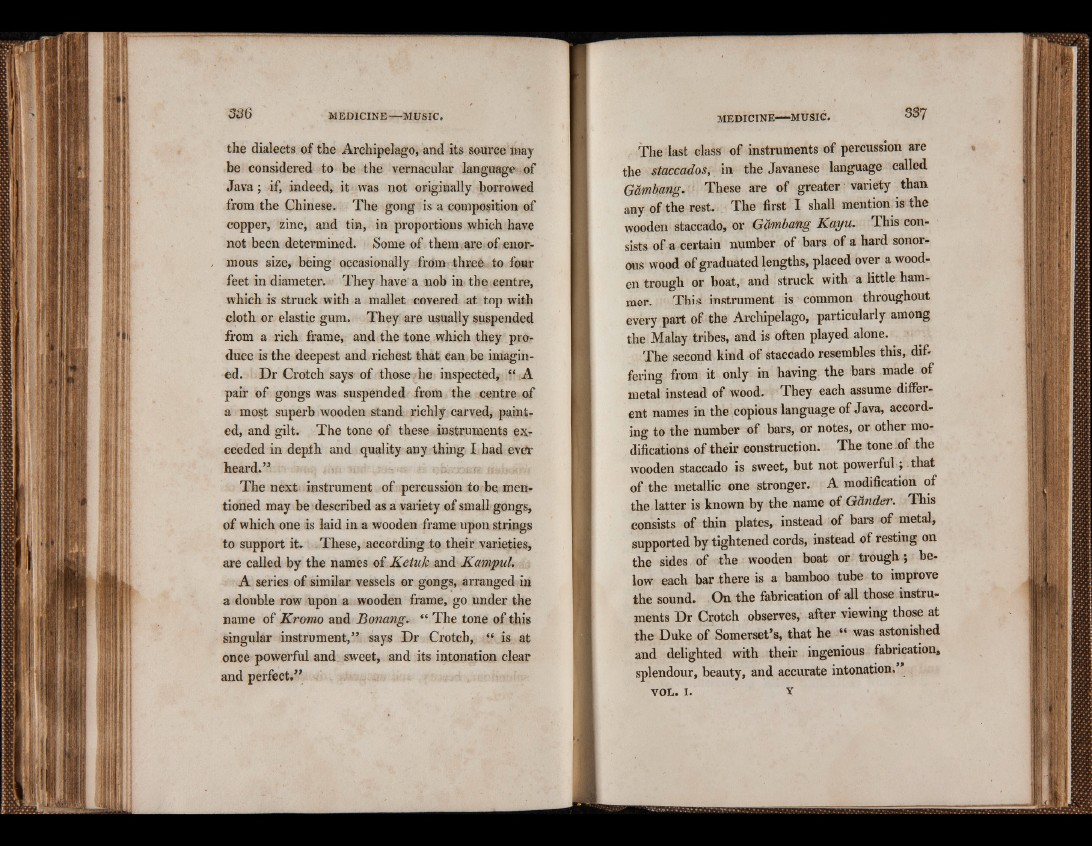
the dialects of the Archipelago, and its source may
be considered to be the vernacular language of
Java; if, indeed, it was not originally borrowed
from the Chinese. The gong is a composition of
copper, zinc, and tin, in proportions which have
not been determined. Some of them.are. of enormous
size, being occasionally from three to four
feet in diameter. They have a nob in the centre,
which is struck with a mallet covered at top with
cloth or elastic gum, They are usually suspended
from a rich frame, and the tone which they produce
is the deepest and richest that can be imagined.
Dr Crotch says of those lie inspected, “ A
pair of gongs was suspended from the centre of
a most superb wooden stand richly carved, painted,
and gilt. The tone of these instruments exceeded
in depth and quality any thing I had ever
heard.” r, ,
The next instrument of percussion to be mentioned
may be described as a variety of small gongs,
of which one is laid in a wooden frame upon strings
to support it. These, according to their varieties,
are called by the names of Ketuk and Kampul.
A series of similar vessels or gongs, arranged in
a double row upon a wooden frame, go under the
name of Kromo and Bonang. “ The tone of this
singular instrument,” says Dr Crotch, “ is at
once powerful and sweet, and its intonation clear
and perfect.”
The last class of instruments of percussion are
the staccados, in the Javanese language called
Gâmbang. These are of greater variety than
any of the rest. The first I shall mention is the
wooden staccado, or Gdmbang Kayu. This consists
of a certain number of bars of a hard sonorous
wood of graduated lengths, placed over a wooden
trough or boat, and struck with a little hammer.
This instrument is common throughout
every part of the Archipelago, particularly among
the Malay tribes, and is often played alone.
The second kind of staccado resembles this, differing
from it only in having the bars made of
metal instead of wood. They each assume different
names in the . copious language of Java, according
to the number of bars, or notes, or other modifications
of their construction. The tone of the
wooden staccado is sweet, but not powerful ; that
of the metallic one stronger. A modification of
the latter is known by the name of Gander. This
consists of thin plates, instead of bars of metal,
supported by tightened cords, instead of resting on
the sides of the wooden boat or trough ; below
each bar there is a bamboo tube to improve
the sound. On the fabrication of all those instruments
Dr Crotch observes, after viewing those at
the Duke of Somerset’s, that he M was astonished
and delighted with their ingenious fabrication,
splendour, beauty, and accurate intonation.
v o l . i . Y